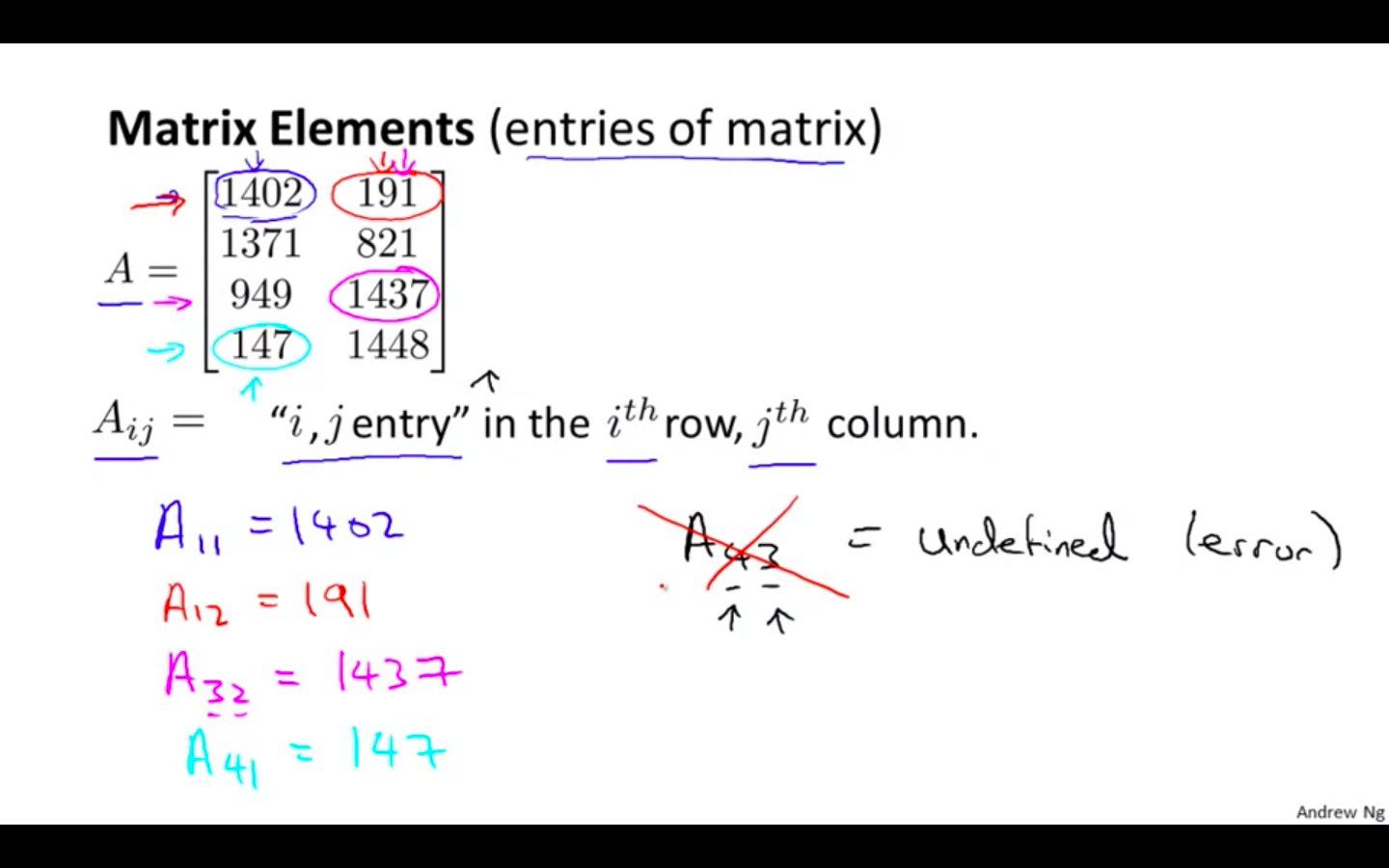Linear Algebra
Matrices and Vectors
-
Matrices
- It is a multi-dimensional array
- Dimension of matrix = number of rows x number of columns
-
Elements Of Matrices
- Elements of the matrix can be accessed using the i or j the term
- i th term = row && j th term = column

- Vectors
- It a a matrix with on column and ‘n’ rows.
- It a a matrix with on column and ‘n’ rows.
- In general, all our vectors and matrices will be 1-indexed. Note that for some programming languages, the arrays are 0-indexed.
- Matrices are usually denoted by uppercase names while vectors are lowercase.
-
“Scalar” means that an object is a single value, not a vector or matrix.
-
Octave/Matlab Snippet
- Code for matrices and vectors
% The ; denotes we are going back to a new row. A = [1, 2, 3; 4, 5, 6; 7, 8, 9; 10, 11, 12] % Initialize a vector v = [1;2;3] % Get the dimension of the matrix A where m = rows and n = columns [m,n] = size(A) % You could also store it this way dim_A = size(A) % Get the dimension of the vector v dim_v = size(v) % Now let's index into the 2nd row 3rd column of matrix A A_23 = A(2,3)
Addition and Scalar Multiplication
-
Matrix Addition Subtraction - Only matrix with same dimensions can be operated.
- Size of the output matrix would be same as the input matrix
-
Scalar Multiplication Division - Scalar gets multiplied or divided to each and every element of the matrix
- Combination of Operands
- Many operations can be combined Combination of operands.png
-
Octave/Matlab Snippet
- Octave/Matlab commands for matrix addition and scalar multiplication.
% Initialize matrix A and B A = [1, 2, 4; 5, 3, 2] B = [1, 3, 4; 1, 1, 1] % Initialize constant s s = 2 % See how element-wise addition works add_AB = A + B % See how element-wise subtraction works sub_AB = A - B % See how scalar multiplication works mult_As = A * s % Divide A by s div_As = A / s % What happens if we have a Matrix + scalar? add_As = A + s
Matrix Vector Multiplication
-
Example 1
- The result is a vector. The number of columns of the matrix must equal the number of rows of the vector.
-
Details
- An m x n matrix multiplied by an n x 1 vector results in an m x 1 vector.
-
Example 2
-
Hypothesis Trick
- Hypothesis can be applied to many values efficiently by using matrix-vector multiplication
- Matrix would be the data set or the value on which hypothesis is to be applied
- Vector would be the hypothesis
- Output would be the predictions from the hypothesis
-
Octave/Matlab Snippet
- matrix-vector multiplication
% Initialize matrix A A = [1, 2, 3; 4, 5, 6;7, 8, 9] % Initialize vector v v = [1; 1; 1] % Multiply A * v Av = A * v
Matrix Matrix Multiplication
-
Example 1
- multiply two matrices by breaking it into several vector multiplications and concatenating the result.
-
Details
- An m x n matrix multiplied by an n x o matrix results in an m x o matrix.
- To multiply two matrices, the number of columns of the first matrix must equal the number of rows of the second matrix.
-
Example 2
- Hypothesis Trick
- Multiple hypothesis can be calculated using matrix matrix multiplication Hypo Trick.png
-
Octave/Matlab Snippets
- matrix-matrix multiplication
% Initialize a 3 by 2 matrix A = [1, 2; 3, 4;5, 6] % Initialize a 2 by 1 matrix B = [1; 2] % We expect a resulting matrix of (3 by 2)*(2 by 1) = (3 by 1) mult_AB = A*B % Make sure you understand why we got that result
Matrix Multiplication Properties
-
Commutative
- Matrices are not commutative
- A _ B ≠ B _ A
- Matrices are not commutative
-
Associative
- Matrices are associative
- (A _ B) _ C = A _ (B _ C)
- Matrices are associative
-
Identity Matrix
- The identity matrix, when multiplied by any matrix of the same dimensions, results in the original matrix.
- When multiplying the identity matrix after some matrix (A∗I), the square identity matrix’s dimension should match the other matrix’s columns.
- When multiplying the identity matrix before some other matrix (I∗A), the square identity matrix’s dimension should match the other matrix’s rows.
-
Octave/Matlab Snippet
% Initialize random matrices A and B A = [1,2;4,5] B = [1,1;0,2] % Initialize a 2 by 2 identity matrix I = eye(2) % The above notation is the same as I = [1,0;0,1] % What happens when we multiply I*A ? IA = I*A % How about A*I ? AI = A*I % Compute A*B AB = A*B % Is it equal to B*A? BA = B*A % Note that IA = AI but AB != BA
Inverse and Transpose
-
Inverse
- Multiplying by the inverse results in the identity matrix.
- A non square matrix does not have an inverse matrix.
- Matrices that don’t have an inverse are singular or degenerate.
-
Transpose
- The transposition of a matrix is like rotating the matrix 90° in clockwise direction and then reversing it.
-
Octave/Matlab Snippet
- compute inverses of matrices in octave with the pinv(A) function and in Matlab with the inv(A) function.
- We can compute transposition of matrices in matlab with the transpose(A) function
% Initialize matrix A A = [1,2,0;0,5,6;7,0,9] % Transpose A A_trans = A' % Take the inverse of A A_inv = inv(A) % What is A^(-1)*A? A_invA = inv(A)*A